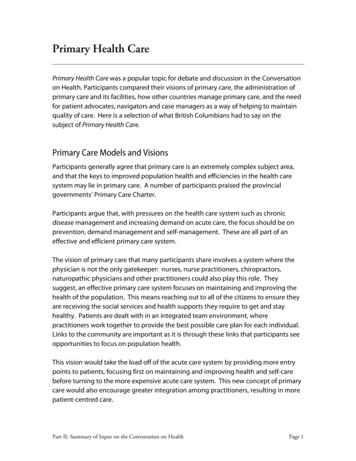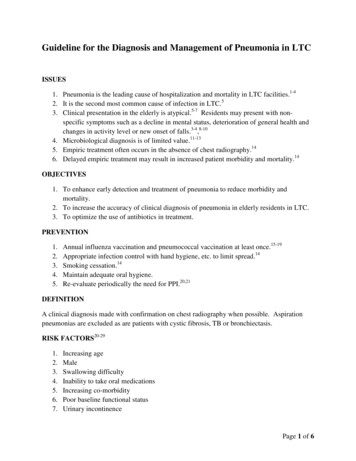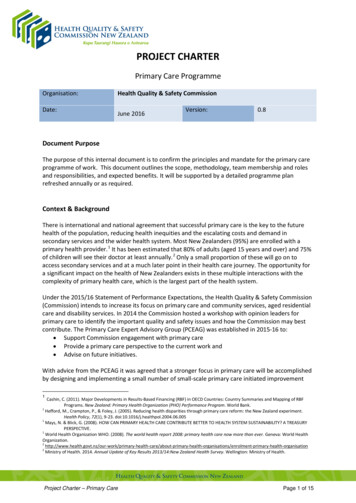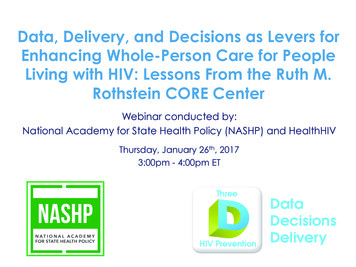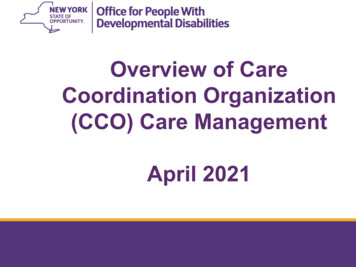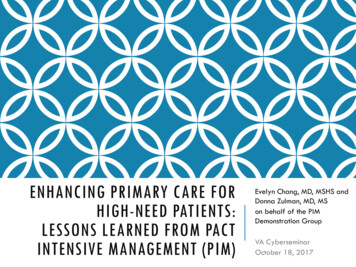
Transcription
ENHANCING PRIMARY CARE FORHIGH-NEED PATIENTS:LESSONS LEARNED FROM PACTINTENSIVE MANAGEMENT (PIM)Evelyn Chang, MD, MSHS andDonna Zulman, MD, MSon behalf of the PIMDemonstration GroupVA CyberseminarOctober 18, 2017
PACT INTENSIVE MANAGEMENT (PIM) STAFFAtlantaClevelandMilwaukeeSalisburySan Francisco Deborah Henry, MD, projectlead Brook Watts, MD, MS, projectlead Jeffrey Jackson, MD, project Parag Dalsania, MD, projectlead Jessica Eng, MD, project lead Kitefre Oboho, MD Rhonda Sturdivant, SW Emma Odotei, SW Jacqueline Lewis, SW Linda Walker, NP LaChaka Coffee-Meadows, DNP Heather Farrow, PhD,psychologist Melissa Klein, MD Cortney Muns, CNS Sudip Roy, MD Nate Ewigman, PhD,psychologist Kim Schaub, PhD, psychologist Sheila Scott, MSN, RN Mishelle Salaam, LPN Robert Carr, RN* Francis Gutierrez, MSN, RN Stephanie Lindsay, RN Stephen Forte, RN Erin Maney, SW Dontae’ Roberts, SW Angela Bodnar, SW Anna Harttert, SW Jennifer Luescher, psychologist Jenah Yangwas, SW Irene Kostiwa, psychologist Shannon Miller, CPPS Barbara Kamholz,psychiatrist* Derek Storch, MSA Daniel Arias, PSA Christine Wurm, project mgr. Dr. Kathy Hedrick,psychologist* Andrew Bisbee, medic Marie Spencer, medic Jenna Pierce, psychologist Ulyana Shramovyat, SW Maki Ishihara-Sanders, SW Ryan Amos, project mgr. Vicki Jones, RN Erin Lea, PhD, psychologist* Walter Bradley, CPPS Mary Hasenstaub, NP* Lynn Seybolt, SW*lead Leikeisha Willaims, projectmgr.* Jennifer Chen, pharmacist* Risa Peets, RN* Emily Doan, RN* Neha Pathak, MD* Jeryl Horton-Pittman, RN* Hazel Headley, RN** Not currently on PIM team
OVERVIEWRationale for Office of Primary Care’s PACT IntensiveManagement (PIM) Demonstration ProgramDescription of 5 PIM Programs12-Month Outcomes Patient Experience PACT Experience Cost & UtilizationLessons LearnedNext Steps
POLL QUESTION: WHAT IS YOUR ROLE IN VA?(SELECT ALL THAT APPLY)A. PACT staff (provider, nurse, clerk)B.Non-PACT clinical staffC. Administrator, clinic managerD. ResearcherE.Other
CLINICAL VIGNETTE FROM PIM TEAMMr. A is a 65 year-old Vietnam Veteran with history of hypertension, chronic lowerback pain, shoulder pain, and polysubstance abuse, who lived with family.He enrolled into PIM during a hospitalization with a new diagnosis of multiplemyeloma. Veteran’s goal was to re-gain independent living within 6 months and to“beat cancer.” PIM team goals were to assist patient with maintaining sobriety andadherence to medication and Hematology/Oncology treatment plan.
CARE FOR HIGH-NEED PATIENTS IS NATIONALPRIORITY
HIGH-COST PATIENTS IN VHASource: Zulman DM, et al., BMJ Open. 2015
VHA’S 5% HIGHEST-COST PATIENTS High rates of hospitalization and ED visits Many patients with complex/costly conditions Cancer, heart failure, renal failure 65% with conditions spanning 3 systems Approximately half with MH conditions High rates of homelessness (14%) Many with inadequate social support (41% married)Source: Zulman DM, et al., BMJ Open. 2015
“HOT SPOTTER” INITIATIVES “Hot Spotter” concept popularized by AtulGawande, 2011, New Yorker Jeffrey Brenner, MD, pioneered using localdata to identify high-cost patients andprovide intensive outpatient care to reducecosts and improve quality These patients were generally not connected toprimary care Other similar interventions followed, butmost were not rigorously evaluatedIn Camden, New Jersey,1% of patients account for1/3 of medical costs.Photograph by PhillipToledano
WHAT IS KNOWN FROM LITERATUREIntervention results are mixed.Some show reductions in hospital admissions, emergencydepartment (ED) visits, costs. Patient outcomes may appear to improve without a comparison groupExisting models not necessarily designed to takeadvantage of medical home and neighborhood resources(i.e., mental health, palliative care, homeless, home-basedprimary care).10
POLL QUESTION: WHAT IS YOUR EXPERIENCEWITH HIGH-RISK PATIENTS?(SELECT ALL THAT APPLY)A. Direct clinical care for high-risk patientsB. Leadership role in program for high-risk patientsC. Research on high-risk patientsD. Other experience with high-risk patientsE. No experience yet
VHA CAN PREDICT VETERANS’ RISK FORHOSPITALIZATION USING THE CAREASSESSMENT NEED (CAN) SCORE20% of Patients with CAN 95 will be hospitalized within 90 days3435% hospitalized30252220171312151050 5 10 20 30 40 50 60 70 80 90 96 98Risk for 90-day hospitalization in percentileFrom Wang, et al. Med Care. 2013.
VHA PRIMARY CARE SERVICES RATIONALEMost high-risk patients are managed in PACTsPatients at highest risk for hospitalizations (“high-risk”) requireprompt, frequent, comprehensive coordination.Even high-performing PACTs struggle with identifying and meetinghigh-risk patient health needs.May not be feasible forCurrent PACT setting for top 5%Veterans (C!N score 95th Percentile)PACT teams alone.1%Need to develop andevaluate approaches tointensive management.7%1%1% 8%PACTWomen's Health-PACTGeri-PACTHomeless-PACT82%Home-Based Primary CareOther13
VHA PRIMARY CARE SERVICES GOALSImprove health care outcomes, functional status, qualityof life, Veteran satisfaction among high-risk patients inprimary care.Reduce emergency department and urgent careutilization, hospitalizations and mortality in high-riskpatients in primary care.Improve provider satisfaction.14
PACT INTENSIVE MANAGEMENT (PIM)SELECTED DEMONSTRATION SITES - 2013MilwaukeeVAMCSan FranciscoVAMC and 2CBOCsClevelandVAMC andCBOCSalisbury VAMCAtlantaCBOC
PACT INTENSIVE MANAGEMENT (PIM)DEMONSTRATION SITE MODELSGRACEAdjunct toPACT TeamsModelsCamdenTransitions inCareSeparate levelandMilwaukeeSalisbury16
WHAT DID PIM TEAMS DO?Met regularly as an interdisciplinary care teamScreened 20-25 high CAN patients per month, triaged patients,notified PACT providers, assessed, and finally engaged Veteransidentified as appropriateNontraditional approaches (e.g., “co-attends,” inpatient visits)Performed care coordination activities Health coaching Communicating/coordinating with other providers Arranging transportation for appointmentsAssisted with medications (e.g., refills, education, adherence)At least four sites included: Home visits to gain patient’s trust and assess environment Mental health and/or addiction assessment and support
RANDOMIZED PROGRAM EVALUATIONDESIGNAny result or outcome from PIM would be difficult to interpretwithout a comparison group.Evaluation team provides lists of patients randomly chosen fromtarget patient population to invite to PIM (2014-2015).PIM targets Veterans with Care Assessment Needs (CAN) 90thpercentile and with a 6-month history of ED visit or hospitalizationin VA setting. Not in a comprehensive care program (H-PACT, HBPC, palliative care, nursinghome) in the past 2 months.Sites can refer a limited number of Veterans into PIM.18
PIM DEMONSTRATION AS RANDOMIZED QUALITYIMPROVEMENT TRIALHigh Risk for hospitalization (CAN score 90th percentile) hospitalization/ED visit 6 monthsIntensive OutpatientManagementPIMN 1105Usual Primary CarePACTN 1102
PIM EVALUATION COMPONENTS Program Activities and Clinical Outcomes Health Factors (CPRS standardized templates) Patient Experience Survey of patients in PIM and PACT (2016) Interviews with patients in PIM (2015-2016) PACT Experience Survey of PACT team members (2014-2016) Interviews with PACT staff: MD, RN, SW (2017) Cost & Utilization CDW Medical SAS files, Managerial Cost Accounting (MCA), Fee-basis data Program costs
WHO WERE THESE HIGH-RISK PATIENTS?Male genderAge, mean ( SD)Marital ce connected 50%Race/ethnicityWhiteNon-whiteNumber of chronic conditions, mean ( SD)HypertensionDepression*Mean # VA ED visits, 12 mo prior ( SD)Mean # VA inpatient stays, 12 mo prior ( SD)*P 0.05PIM, N 110590%63 (12)PACT, N 110290%62 (13)33%50%17%40%32%45%22%38%49%48%51%52%7 (3)7 (3)68%65%33%37%1.9 (1.5)1.9 (0.6)1.3 (0.7)1.4 (0.8)SD standard deviation
PACT INTENSIVE MANAGEMENT (PIM)LESSONS LEARNEDNot all high-risk patients need intensive management. 390/1105 (35%) patients were not contacted or could not be contacted They were considered by PIM teams to be ineligible (e.g., outside eligibilityarea for home visits; mental health or substance use condition; noambulatory care-sensitive condition) They were thought to be receiving appropriate management in PACTHalf of high-risk patients identified for PIM team wereenrolled. 572/1105 (52%) patients received PIM services22
FOLLOW-UP ON MR. AMr. A is a 65 year-old Vietnam Veteran with history of hypertension, chroniclower back pain, shoulder pain, and polysubstance abuse, who lived with family.He enrolled into PIM during a hospitalization with a new diagnosis of multiplemyeloma. Veteran’s goal was to re-gain independent living within 6 months andto “beat cancer.” PIM team goals were to assist patient with maintaining sobrietyand adherence to medication and Hematology/Oncology treatment plan.NP&SW assisted with discharge to home and performed a home visitassessment. Interventions also included co-attending specialty visits (VA and nonVA) and providing support and education in the home and over thetelephone. NP referred patient to a substance abuse treatment program after abrief relapse. SW provided supportive counseling, as well as community referralsfor housing and furniture.After 5 months, the Veteran moved into subsidized housing. He continues toadhere to the Hem/Onc plan of care. His WBC count is improving, and he hasbeen sober for 6 months.
PATIENTS REPORTED POSITIVE EXPERIENCESWITH PIM Most would recommend PIM to other Veterans Several commented that PIM should be continued orexpanded“My health has gotten a little better since they took over becausethey got me on the right medication, and they showed me theproper foods that I needed to eat for my diabetes. They sat medown and clearly made everything so understandable I never gotthat before.” (#155)“ I know I can count on them, I know I can call them if I everhave a problem or anything like that, and they have given mecourtesy calls and I like that too, just in case We work welltogether.” (#62)Source: 2016 Interview with Patients (n 51)
PIM PATIENT SURVEY (2016)Objective: Determine whether PIM is associated with improved patientexperiencePopulation: High-risk patients randomly assigned to PIM or PACTMode: Mailed survey with follow-up by phoneRespondents: 1283 PIM (768 responses; response rate 60%) 1283 PACT (759 responses; response rate 59%)Primary Outcomes: Satisfaction, Access, Care Coordination, Patient-Centered CareAnalyses: Multivariate regression with site-level fixed effects
PATIENTS IN PIM TRUSTED PROVIDERS IN VA MORETHAN THOSE WHO WERE NOT IN PIMGot needed servicesEase in getting carePIMEasily accessible providerPACTRespect from providerHave a trusted providerHelp with coordination of care0%10% 20% 30% 40% 50% 60% 70%Strongly AgreeSource: 2016 Survey of High-Risk PIM and PACT Patients (N 1527)
PATIENTS IN PIM TRUSTED PROVIDERS IN VA MORETHAN THOSE WHO WERE NOT IN PIMGot needed servicesEase in getting careEngagedEasily accessible providerPIMPACTRespect from provider*P 0.05Have a trusted providerHelp with coordination of care0%10% 20% 30% 40% 50% 60% 70%Strongly AgreeSource: 2016 Survey of High-Risk PIM and PACT Patients (N 1527)
TREND TOWARDS IMPROVED PATIENT-CENTEREDCARE AMONG PIM PATIENTSTalked about health goalsAsked about barriers to careEngagedPIMTalked about prescriptionsPACTReceived reminders from PCPPCP up-to-date0%50%% reporting service in previous 6 months100%
TREND TOWARDS IMPROVED CARE FOR CHRONIC ILLNESSAsked how visits with otherdoctors were goingTold how visits with specialisthelped your treatmentEngagedPIMReferred to a dietician, healtheducator, or counselorPACTEncouraged to attendcommunity programsContacted after a visit0%10%20%% always30%40%
PACT SURVEY SAMPLEInvited Primary Care Providers (MD, PA, NP) and Nurses(RN, LVN, LPN) practicing at the five PIM demonstrationsite medical centers VAMC, CBOC, ambulatory care clinics Not still in training (i.e., resident, trainee) May not be exposed to PIMWave 1: Fielded online Dec 2014 – Jan 2015, paper andonline May 2015 – June 2015. Response rate: 45%Wave 2: Fielded online & paper October 20, 2016 January 6, 2017. Response rate: 34%
PACT PROVIDERS WANT HELP WITH CARING FORHIGH-RISK PATIENTSCaring for high-risk patients is one of the moststressful aspects of my job (49%)Overall, I am satisfied with the help I receive tocare for my high-risk patients (39%)My job would be better if I had aninterdisciplinary team to help care for my highrisk patients (78%)Source: 2014-15 Survey of PACT Providers and Nurses (N 447)
PACT STAFF NEED HIGH LEVEL OF ASSISTANCEOUTSIDE OF PACT TO MANAGE PATIENTS WITH:Chronic pain (50%)Frequent walk-in visits (46%)Poor self-management for problems, symptoms, or illnesses (43%)Medical conditions and comorbid psychiatric disorder (42%)Poor adherence to critical medications (42%)Frequent hospitalizations or emergency department visits (41%)Medical conditions and comorbid substance use disorder (40%)Source: 2017 Survey of PACT Providers and Nurses (N 294)
WHY DO HIGH-RISK PATIENTS REQUIRE TIMEAND RESOURCES FROM PRIMARY CARE TEAMS?Patients withpsychosocial andbehavioral issues,learning deficitsDifficulty managing patients with MH problemsPoor patient self-managementOverly dependent and demanding ptsLack of timely response from specialistsUnclear primary and specialty care responsibilitiesProblems withcoordinationand communicationInsufficient staffing, resources for care coordinationPoor communication with specialists for co-managedpatientsDifficulty coordinating care across multiple clinics,providers, and servicesLack of control over my scheduleLack of support from local leadership0%5%10% 15% 20% 25% 30% 35% 40% 45%% of respondentsSource: 2014-15 Survey of PACT Providers and Nurses (N 447)33
PACT PROVIDERS WERE MORE SATISFIED WITH HELPRECEIVED HIGH-RISK PATIENTSNOTE: GRAPH SHOWS ADJUSTED RESULTS; WEIGHTED FOR NONRESPONSE, CLUSTERED BY SITES5PIM PACT: PrePIM PACT: PostPACT: PrePACT: Post4321Job satisfactionIntent to continue Satisfaction with helpworking in PACT for received for high-risknext 2 yearspatients†† p 0.06 after adjusting for provider-level and site-level covariatesSource: 2015 Survey of PACT Providers and Nurses (N 447) and 2017 (N 294)
PACT PROVIDERS THOUGHT PIM WAS HELPFULPACT providers thought that PIM helpful for time-consumingpatients, transitions of care, understanding Veterans’ barriers tocare in their home/community environments“ when you have more people involved in the care, sometimes it does add to yourworkload because there’s more being told to you . But in general, I think theyvery much help with my workload and also with my sense that we’re providing reallygood care to the patients, because they’re able to do things that I might not haveeven had time to do.” (PACT PCP - #103)Source: Interviews with PACT teams, 2016-2017 (n 29)
TOP REASONS FOR WHY PCPS WANTEDPIM INVOLVEDAdherence to medications, treatments, or appointments (n 124)Home assessment and evaluation (n 124)Comprehensive assessment of medical & psychosocial needs,care planning (n 115)Self-management and lifestyle changes (n 63)Difficult-to-control symptoms or illnesses (n 59)Other: Education about dx and appropriate VA resources,alcohol use, financial abuse by caregiver, hoarding, fall risk,difficult personality, transportation, driving safety, cognitivescreening, anger, pain management, transgender resourceSource: Health Factor Data as of March 31, 2016
COST AND UTILIZATION ANALYSESMETHODSIntent-to-treat analysis using differences-in-differences(DID) 12-month period prior to and 12-months followingrandomized assignment.Outcomes included utilization (hospitalizations, ED visits,outpatient visits by type) and VA costsOrdinary Least Squares for regression models Sensitivity analyses using models for count data models, Generalized LinearModels and log costsFixed effects for patient
NO SIGNIFICANT EFFECT ON ACUTE CAREUTILIZATION AFTER 12 MONTHS3.5PIM PreRandomizationPIM PostRandomizationPACT PreRandomizationPACT PostRandomization# visits/stays per patient 32.521.510.50HospitalizationsD-D-0.5 Predictedmeans from regression modelsED visitsD-D
INPATIENT COSTS INCREASED SLIGHTLYAMONG PATIENTS IN PACT 18,000 16,000 14,000 12,000PIM Pre-RandomizationPIM Post-RandomizationPACT Pre-RandomizationPACT Post-RandomizationDifference-in-Difference 10,000 8,000 6,000 4,000 2,000 0- 2,000- 2,277- 4,000 Predictedmeans from regression models
OUTPATIENT COSTS INCREASED SIGNIFICANTLYAMONG PATIENTS IN PIM 25,000 20,000PIM Pre-RandomizationPIM Post-Randomization 15,000PACT Pre-Randomization 10,000 5,000 0 Predictedmeans from regression modelsPACT PostRandomizationDifference-in-Difference [VALUE]* p 0.01
OVERALL NO DIFFERENCE IN TOTAL COSTS 35,000 30,000 25,000 20,000 15,000PIM Pre-RandomizationPIM Post-RandomizationPACT Pre-RandomizationPACT Post-RandomizationDifference-in-Difference 10,000 5,000361 Predicted 0means from regression models
POTENTIAL EXPLANATIONS FOR MODESTEFFECTS ON COST Benefits of intensive management may require more time(e.g., to build trust, change behavior and chronic conditionmanagement, decrease complication rates). Program may be effective for certain patients, but selectionprocess included patients unlikely to benefit (e.g., not likelyto engage, non-modifiable risk factors) PIM may lead patients to seek care within rather thanoutside VA Need to refine match between patient needs and expertise(e.g., mental health, geriatrics)
LESSONS LEARNED:IMPORTANT KEY PIM FEATURESTeams should include both a social worker and a mentalhealth provider (e.g., psychologist).Teams should meet at least weekly to discuss high-risk patientsand their treatment plans.Comprehensive assessment should include assessment ofpatient goals and physical, psychological, social needs.Many patients with trajectories that may not change, soadvanced care planning importantProviding caregiver education and support important forbehavior change.
LESSONS LEARNED:PIM DEMONSTRATION PROGRAM Rigorous evaluation critical High-cost/high-utilizers experience regression to mean Implementing intensive management programs takes time Hiring/training, refining program in response to patients’ needs,building relationships with PCPs/specialists, engaging patients andbuilding trust One-size-fits-all approach likely ineffective Certain patients more likely to engage in and respond to theseprograms Some patients may benefit from in-depth assessment andrecommendations, but not need ongoing PIM support Provider referral could help identify patients likely to benefit fromPIM Iterative improvement and evaluation key to care redesign
SUMMARYPACT Intensive Management (PIM) initiative is an opportunity forVHA to learn about how to better manage high-needs, high-costpatients as a learning healthcare organizationFive demonstration sites have developed innovative carecoordination strategies and served as expert resource to theirPACT teamsPatients and PACT teams have appreciated the help that PIMteams offerPIM program paid for itself
FUTURE OF PIM DEMONSTRATION: PIM 2.0PIM 2.0 standardized model consists of: Referral program at the 5 demonstration sites (October 2017 –Sept 2018) Interdisciplinary team with MD, RN, SW, MH provider Adjunct to PACT rather then stand-alone PACT Population-level interventions, PACT-level interventionsDevelopment of tools to assist PACT teams in caring forhigh-risk patients, to be released in 2019
ACKNOWLEDGEMENTS:MEMBERS OF PIM INITIATIVEPIM Demonstration sites: Parag Dalsania, Jessica Eng, Nate Ewigman, DeborahHenry, Jeff Jackson, Neha Pathak, Brook WattsPIM Executive Committee: Gordon Schectman, Kathy Corrigan, Tim Dresselhaus,David Atkins, Carrie Patton, Belinda Black (Velazquez)PIM National Evaluation CommitteeLisa Rubenstein (CSHIIP, Los Angeles)Steve Asch (Ci2i, Palo Alto)Evelyn Chang (CSHIIP, Los Angeles)Donna Zulman (Ci2i, Palo Alto)Jean Yoon (HERC, Palo Alto)Michael Ong (CSHIIP, Los Angeles)Susan Stockdale (CSHIIP, Los Angeles)Marian Katz (CSHIIP, Los Angeles)Elvira Jimenez (CSHIIP, Los Angeles)Mingming Wang (CSHIIP, Los Angeles)Ava Wong (PIM NEC, VA Palo Alto)Angel Park (HERC, Palo Alto)Karen Chu (CSHIIP, Los Angeles)Andrew Lanto (CSHIIP, Los Angeles)Shoutzu Lin (Ci2i, Palo Alto)Cindie Slightam/Terri Rogers (ImPACT, Palo Alto)Alissa Simon (CSHIIP, Los Angeles)Debbie Delevan (CSHIIP, Los Angeles)Lisa Tarr (CSHIIP, Los Angeles)
ATLANTA PIM TEAMJeryl Horton-Pittman, RN Case Manager/Coordinator;Walter Bradley, Peer Support Specialist, EmmaOdotei, SW, Linda Walker, NP; Rhonda Sturdivant, SW
CLEVELAND PIM TEAMCleveland “Allies for Better Care (ABC)PACT”:Ryan Amos, PSA: Melissa Klein, MD; Maki IshiharaSanders, SW; Marie Spencer, ICT; Kim Schaub,clinical psychologist; Jenna Pierce, clinicalpsychologist; Erin Lea, clinical psychologist; BrookWatts, Project Lead; Andrew Bisbee, ICT
MILWAUKEE PIM TEAMFrances Gutierrez, CNE; Cortney Muns, CNS;Derek Storch, MSA; Sheila Scott, CNE;Irene Kostiwa, clinical psychologist
SALISBURY PIM TEAMDaniel Arias, PSA; Dontae’ Roberts, LCSW;Roy Sudip, MD; Mishelle Salaam, LPN
SAN FRANCISCO PIM TEAMJessica Eng, Project Lead/MD; Stephen Forte, RN;Jenah Yangwas, SW, Angela Bodnar, SW;Nathan Ewigman, clinical psychologist; Robert Carr, RN
QUESTIONS/COMMENTS?Contact information:Evelyn Chang, MD, MSHS (evelyn.chang@va.gov)Donna Zulman, MD, MS (donna.zulman@va.gov)
Atlanta Cleveland Milwaukee Salisbury San Francisco Deborah Henry, MD, project Brook Watts, MD, MS, project Jeffrey Jackson, MD, project Parag Dalsania, MD, project Jessica Eng, MD, project lead lead lead lead lead Nate Ewigman, PhD, Melissa Klein, MD Kitefre Oboho, MD Cortney Muns, CNS Sud




